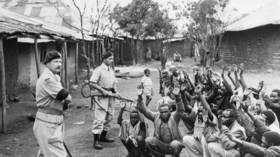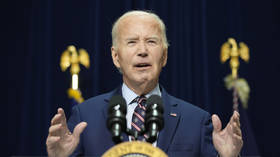October 5, 2000: Flashback to Yugoslavia, West's first color revolution victim

While Washington makes evidence-free claims of Russian interference in US politics, it is worth remembering an epidemic of “color revolutions” around the world openly sponsored by the US, which began in Serbia 17 years ago.
October 5, 2000 now seems a lifetime ago. It is worth reaching that far back in the memory to the first “color revolution,” a technique developed to overthrow governments Washington disliked and replace them with more favorable and compliant ones.
According to the official narrative crafted by the Western media and their franchises in Serbia, the righteous people revolted against the corrupt, dictatorial regime of Slobodan Milosevic, took to the streets of Belgrade, stormed the public TV station and the parliament, and established freedom and democracy without bloodshed.
There is just one problem. None of it is true.
The US had long tried to replace Milosevic with someone more willing to obey unconditionally and remake what was then still Yugoslavia into yet another eastern European country that was “transitioned” from Communism and despoiled in the process. Previous attempts at doing so, from the 1995 intervention in Bosnia to the 1999 NATO attack and occupation of Kosovo, had failed.
After Milosevic held out against the alliance for 78 days and eventually struck a negotiated armistice, agents of the National Endowment for Democracy (NED), the Soros Open Society Fund, USAID and other quasi-NGOs answering to Washington stepped up plans for regime change by other means.
US Ambassador Richard Miles “midwifed” the creation of the 'Democratic Opposition of Serbia' (DOS), a hodgepodge of small parties centered on the Democrats. The party’s leader, Zoran Dindic, was kept in the shadows since he polled in single digits. Instead, the coalition’s public face was Vojislav Kostunica, a mild-mannered law professor with no political baggage, picked as the best candidate against Milosevic in the September 24 presidential election.
Meanwhile, a student movement called 'Otpor' (Resistance) was quickly taken over by US-trained activists, like Srda Popovic. Training sessions in Hungary, run by NED contractors instructed Otpor activists, taught participants how to ridicule, disrupt and attack the government through civil disobedience. "Suitcases of cash” smuggled across the border paid for posters, placards, t-shirts, street art and other branding, all featuring the iconic fist logo. Another key NGO funded from the West was the Center for Free Elections and Democracy (CESID), a self-appointed vote watchdog whose claims directly contradicted the official electoral commission.
After the government announced that neither candidate got 50 percent of the vote and a runoff would be required, DOS and Otpor called for a general strike and mass street protests on October 5. Protesters stormed the Yugoslav Parliament and torched the ballot boxes stored there, conveniently obliterating any evidence of who might have actually won the election.
After meeting with Kostunica, Milosevic agreed to step down peacefully, robbing the rebels of some of their momentum. As a result, Đindic was unable to implement the full revolutionary agenda, with Kostunica objecting to his trampling of the laws in the name of “reformist” expediency.
Ever since then, however, who ruled Serbia has never really been decided at the ballot box but at the US embassy, with either pre- or post-electoral alliances or cynical schemes to manipulate the parliamentary majority. Most recently, in 2012, leaders of the Radical Party re-branded themselves as the Progressives to get the US blessing to take over – and went on to deliver most of Washington’s demands when it came to giving up the occupied province of Kosovo, among other things.
Exporting 'democracy'
None of this really mattered to the revolution’s backers; they only wanted a vassal regime in Belgrade, the actual rule of law, democracy or human rights in Serbia be damned. They also decided the October 5 formula was too good to be used just once and set out to deploy it elsewhere.
Ambassador Miles oversaw the 2003 'Rose Revolution' in Georgia, installing in power the US-educated Mikhail Saakashvili. This, too, proved detrimental to the country’s actual inhabitants: Saakashvili started the August 2008 war with Russia, lost the war, and the 2012 election, and fled the country before he could be arrested for corruption. He later joined the US-backed government in Ukraine, but that’s another story.
In 2004, the US sponsored the 'Orange Revolution' in Kiev, backing a DOS-like coalition led by Viktor Yushchenko. By that point, Washington wasn’t even pretending to be uninvolved.
"US campaign behind the turmoil in Kiev," ran a Guardian headline from November 26, 2004, talking about the role of Miles in Georgia and his colleague Michael Kozak in Belarus.
“The operation - engineering democracy through the ballot box and civil disobedience - is now so slick that the methods have matured into a template for winning other people's elections," wrote the Guardian’s Ian Traynor, noting that “the campaign was first used in Europe in Belgrade in 2000.”
A decade later, 'color revolution' techniques would once again be used in Ukraine, culminating in the February 2014 coup against President Viktor Yanukovich and the subsequent crisis in Crimea and the Donbass.
Mind-snatchers
The manual for this kind of coup was written by US scholar Gene Sharp. But it was the former Otpor activists who spread it across the world. In 2004, Popovic founded CANVAS (Center for Applied NonViolent Action and Strategies) and began traveling the world peddling his revolutionary methods to whoever was Uncle Sam’s next target.
A 2011 documentary about the revolution business followed Otpor/CANVAS activity to North Africa during that year’s 'Arab Spring' uprisings.
Wherever they go, these agents of chaos infect the target country’s politics, manipulating genuine local activists into becoming the agents of their people’s demise. While they preach democracy, their dirty tricks are effectively destroying its credibility in the long term. That’s fine with them, however; the objective is not democracy but obedience. Besides, they won’t stick around to see the consequences - there is always the next revolution to plan and execute.
And they always mobilize the young, known for their excess of emotion and shortage of wisdom. They sing the seductive song of “bringing down a dictator” (there’s even a documentary! With a celebrity narrator!) to people who think that will solve all of their problems.
Before the dust from the 'revolution' clears, however, the CANVAS consultants have moved off to the next target, leaving their duped students to watch in horror as their countries descend into strife or chaos. If they are extremely lucky, they end up replacing one corrupt regime with another, only this time beholden to foreign masters.
While the 'color revolutions' are not always successful, even the failed ones cause severe damage to the target country’s politics. Also, once infected, a country is always in danger of relapse.
Popovic was most recently sighted in Hungary, at the beginning of September, amid growing protests against that country’s stubbornly independent government that eerily resemble the blueprint established in Serbia, 17 years ago.
Nebojsa Malic for RT
The statements, views and opinions expressed in this column are solely those of the author and do not necessarily represent those of RT.













